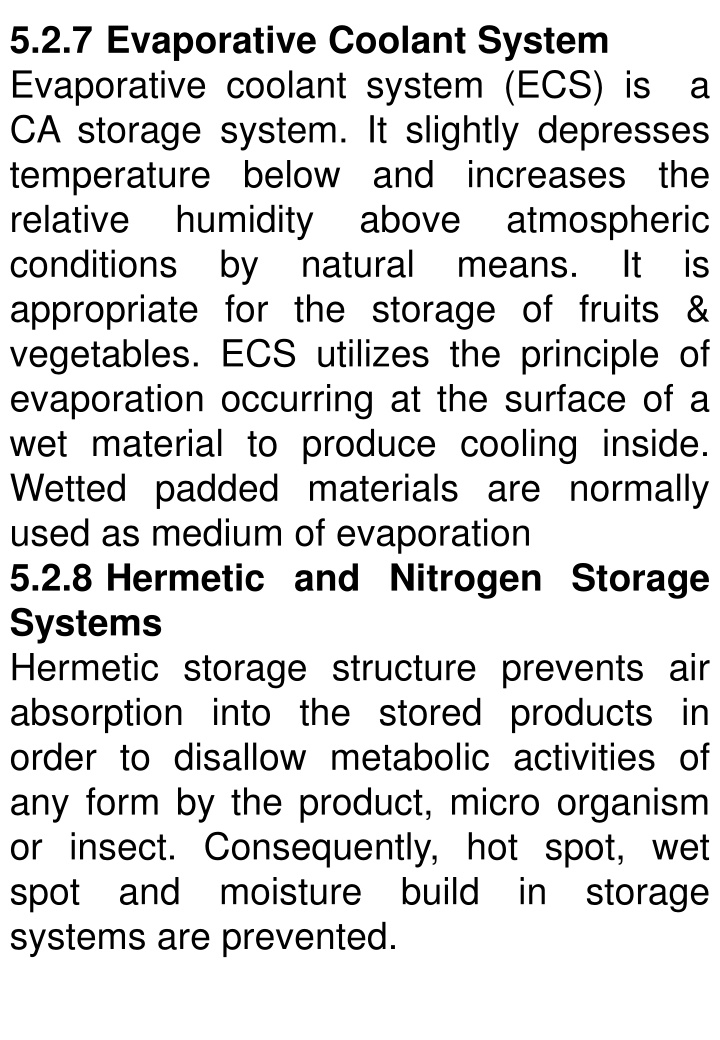
Efficient Food Storage Techniques for Quality Preservation
Discover advanced food storage methods like Evaporative Coolant System, Hermetic Storage, Nitrogen Storage, and Drying of Stored Products to enhance food quality, prevent spoilage, and ensure food security. Learn about the importance of strategic food reserve policies for national and global food security.
Download Presentation

Please find below an Image/Link to download the presentation.
The content on the website is provided AS IS for your information and personal use only. It may not be sold, licensed, or shared on other websites without obtaining consent from the author. If you encounter any issues during the download, it is possible that the publisher has removed the file from their server.
You are allowed to download the files provided on this website for personal or commercial use, subject to the condition that they are used lawfully. All files are the property of their respective owners.
The content on the website is provided AS IS for your information and personal use only. It may not be sold, licensed, or shared on other websites without obtaining consent from the author.
E N D
Presentation Transcript
5.2.7 Evaporative Coolant System Evaporative coolant system (ECS) is a CA storage system. It slightly depresses temperature below and increases the relative humidity above conditions by natural means. It is appropriate for the storage of fruits & vegetables. ECS utilizes the principle of evaporation occurring at the surface of a wet material to produce cooling inside. Wetted padded materials are normally used as medium of evaporation 5.2.8 Hermetic and Nitrogen Storage Systems Hermetic storage structure prevents air absorption into the stored products in order to disallow metabolic activities of any form by the product, micro organism or insect. Consequently, hot spot, wet spot and moisture build in storage systems are prevented. atmospheric
Gas (nitrogen, oxygen, etc) storage structure provides devices that allows essential gas such nitrogen or oxygen to be introduced and preserved the system in order to prevent ripening or/ and metabolic activities. Some silo and cold storage structures are provided with such facilities 6.0 DRYING OF STORED PRODUCT Drying is the removal of water molecules to appreciable storage level. When moisture content below 9% the process is called dehydration. Drying is achieved by passing hot air stream through product. The main aims of drying agricultural products include preservation of optimal quality safe storage; and creation of an environment that would not be favorable for the growth of mould and insect. Drying also eliminates unnecessary water content that contribute to the weight of agricultural material. It also makes the packaging of product easy. The most important product-factor to be noted during dry is moisture content. Product could be harvested at the optimum harvesting moisture content (about 25%) and reduced to an optimum storage moisture level of 12 13%. If crops are harvested at the right time, farmers could save as high as 35% of product
Drying is essential during storage because of the following reasons: Metabolic activities of agricultural materials Variations in the ambient conditions Activities of micro organisms and insects Direct admission of water into storage systems through leaking roof, wall or floor Moisture build in storage structures due to condensation and wet spot, etc A dryer is required to supply heated air for drying during storage. A dryer has the following basic components: Heat source to supply heat Fan to move the heat Duct to channel the heated air Insulator to ensure minimal heat loss Control systems to regulate air parameters such as temperature, relative humidity, flow rate, enthalpy, entropy, etc Classification of dryers is based on the following: Principle of operation (Natural, mechanical, solar) Mode of air & product movement (Co current, counter current, cross flow) Level of technology automated, fully automated) (conventional, semi
7.0 This is a national and global approach to ensuring food security and a means of preventing food insecurity. Every nation is expected to formulate policies to support the storage of agricultural and food materials in large scale in order to meet immediate and future national food needs. State and Local Governments are also expected to participate. Such policies must support both the production and preservation of food materials. The implementation of strategic food reserve policies must also be rigorously pursued to ensure the success of such policies. Strategic food reserve policies must focus on targeted priority crops and food items in the various Local Government and States and in the nation as a whole. The use and management of large scale storage structures for the priority crops and Strategic Food Reserve



















